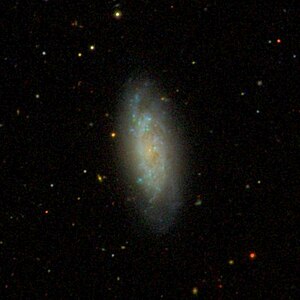NGC 4420
| Galaxy NGC 4420 / UGC 7549 |
|
|---|---|

|
|
| SDSS recording | |
| AladinLite | |
| Constellation | Virgin |
|
Position equinox : J2000.0 , epoch : J2000.0 |
|
| Right ascension | 12 h 26 m 58.5 s |
| declination | + 02 ° 29 ′ 40 ″ |
| Appearance | |
| Morphological type | SB (r) bc: / HII / LINER |
| Brightness (visual) | 12.0 mag |
| Brightness (B-band) | 12.8 mag |
| Angular expansion | 2.00 × 1.0 |
| Position angle | 8 ° |
| Surface brightness | 12.6 mag / arcmin² |
| Physical data | |
| Affiliation | Virgo cluster LGG 287 |
| Redshift | 0.005621 ± 0.000020 |
| Radial velocity | 1685 ± 6 km / s |
|
Stroke distance v rad / H 0 |
(71 ± 5) x 10 6 ly (21.9 ± 1.5) Mpc |
| history | |
| discovery | Wilhelm Herschel |
| Discovery date | January 24, 1784 / February 23, 1784 |
| Catalog names | |
| NGC 4420 • NGC 4409 • UGC 7549 • PGC 40775 • CGCG 042-106 • MCG + 01-32-64 • IRAS 12244 + 0246 • 2MASX J12265847 + 0229396 • VCC 957 • GC 2970 • GC 2978 • H II 23 • H III 17 • h 1263 • HIPASS J1226 + 02 • LDCE 0904 NED116 | |
NGC 4409 = NGC 4420 is an active bar-spiral galaxy with extensive star formation areas of the Hubble type SBbc in the constellation Virgo on the ecliptic . It is an estimated 71 million light years away from the Milky Way and has a diameter of about 45,000 ly.
The galaxy is listed as a member of the Virgo Galaxy Cluster under catalog number VCC 957 . It is the brightest galaxy in the vicinity of 3C 273 and is not far from a Lyman-α cloud in this area. The galaxy is a member of the Virgo supercluster . It is the brightest galaxy in the vicinity of 3C 273 and is not far from a Lyman-α cloud in this area.
The object was discovered by Wilhelm Herschel , who observed it on January 24, 1784 and February 23, 1784, although he did not recognize the double observation. As a result, two entries in the New General Catalog refer to this galaxy, NGC 4420 and NGC 4409 .
